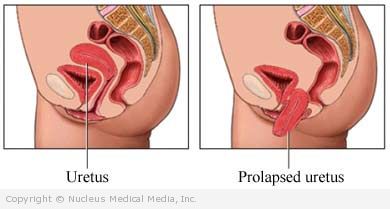(Pelvic Floor Hernia; Pudendal Hernia; Pelvic Relaxation)
Uterine prolapse – Definition
Uterine prolapse occurs when the uterus slips out of place and into the vaginal canal. The severity of uterine prolapse is defined as:
- First degree (mild) — the cervix (the lower opening of the uterus into the vagina) protrudes into the lower third of the vagina
- Second degree (moderate) — the cervix protrudes past the vaginal opening
- Third degree (severe) — the entire uterus protrudes past the vaginal opening
Uterine prolapse – Causes
The uterus is normally supported by pelvic connective tissue and held in position by special ligaments. Weakening of the tissue causes the uterus to descend into the vaginal canal.
Uterine prolapse – Risk Factors
These factors are associated with an increased risk of uterine prolapse:
- Multiple pregnancies and vaginal deliveries
- Retroverted uterus (positioned backwards from normal)
- Age (especially after menopause)
- Obesity — places additional strain on the supportive muscles of the pelvis
- Large uterine or ovarian tumors
- Activities that increase pressure on the abdomen and pelvis, such as:
- Severe or long-standing constipation
- Chronic coughing (especially in smokers)
- Heavy lifting
- Race: Caucasian
Uterine prolapse – Symptoms
There may be no symptoms for mild cases of uterine prolapse. Symptoms for more severe cases may include:
- Sensation of fullness in the vagina
- Sensation of pulling in the pelvis
- Pain in the vagina, lower back, or lower abdomen
- Vaginal discharge
- Leakage of urine
- Difficulty voiding urine
- Frequent urinary tract infections
- Protrusion of pink tissue from the vagina that may be irritated or itchy
Uterine prolapse – Diagnosis
Your doctor will ask about your symptoms and medical history. A physical exam will also be done. This includes a pelvic exam.
Uterine prolapse – Treatment
Treatment may include:
Kegel Exercises
For mild cases of uterine prolapse, Kegel exercises may be recommended to strengthen the pelvic muscles. These exercises are easy to do and can be done anywhere, at any time. To do Kegel exercises:
- Squeeze the pelvic muscles as though you are trying to hold back urine.
- Hold this position for a count of ten, then release slowly.
- Do this 10 times, four times daily.
Medication
Estrogen may help prevent further weakness of the pelvic floor. Talk to your doctor about the risks and benefits of this form of therapy.
Your doctor may recommend that you take a stool softener or a laxative to treat constipation.
Pessary Insertion
This is a rubbery, doughnut-shaped device. It is inserted by your doctor into the upper part of the vagina. A pessary helps to prop up the uterus and bladder, and temporarily prevents sagging into the vagina. It will need to be removed for cleaning. Depending on the type of pessary, you may be able to have sex with the device in place.
If you have a pessary, follow these guidelines:
- Periodically remove the device. To remove it, empty your bladder. Insert two fingers into your vagina. Grab the pessary, slowly turn it, and pull down. Find a good position (eg, lying down, squatting over a toilet, or with one leg lifted on a chair or toilet).
- Clean the device with soap and water as directed. In some cases, you may need to go to the doctor’s office to have your device cleaned.
- To insert it, apply a lubricant (eg, KY Jelly) to the tip of the pessary. Open your vagina with one hand, and insert the pessary with the other. Firmly push up.
- Report any discomfort to your doctor.
Surgery
Surgery may be needed for severe uterine prolapse. These procedures are usually not done until you have finished having children. Options include:
- Hysterectomy — This is the removal of the uterus through the vagina. This will permanently resolve uterine prolapse, but it also results in infertility.
- Vaginal repair — This is usually done with a hysterectomy. The repair can be done with sutures and with sutures alone or with insertion of mesh and slings
- Colpocleisis — This involves closing the vagina. It is done only in women who are elderly and who are no longer sexually active.
Lifestyle Changes
If you smoke, ask your doctor about strategies to quit. Smoking can cause a chronic cough, which can further weaken your pelvic muscles.
If you have to do a lot of heavy lifting, talk to your doctor about effective lifting techniques. Lifting may also weaken your pelvic muscles.
Uterine prolapse – Prevention
To help prevent uterine prolapse:
- Do Kegel exercises regularly, especially before and after childbirth.
- Avoid constipation. Straining from constipation stresses the pelvic muscles.
- Maintain a healthy weight through diet and exercise.
- Quit smoking.
- Limit heavy lifting.
- If you are menopausal, talk to your doctor whether hormone replacement therapy is good choice for you.

